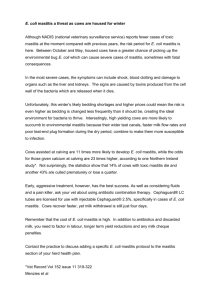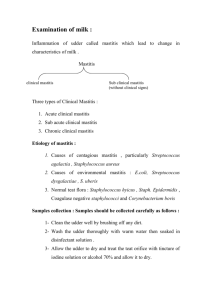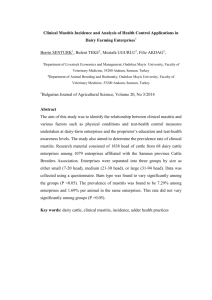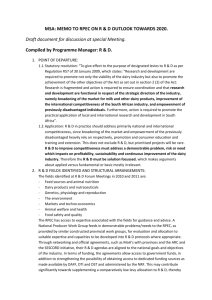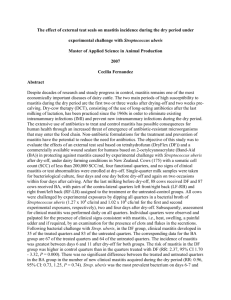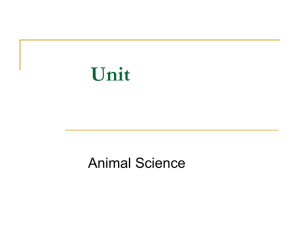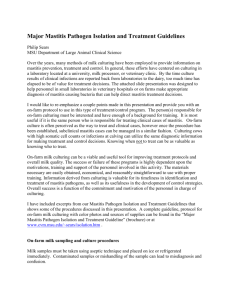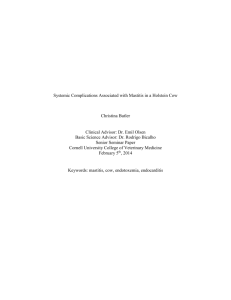VPM 201: Veterinary Bacteriology and Mycology Laboratory 4A
advertisement
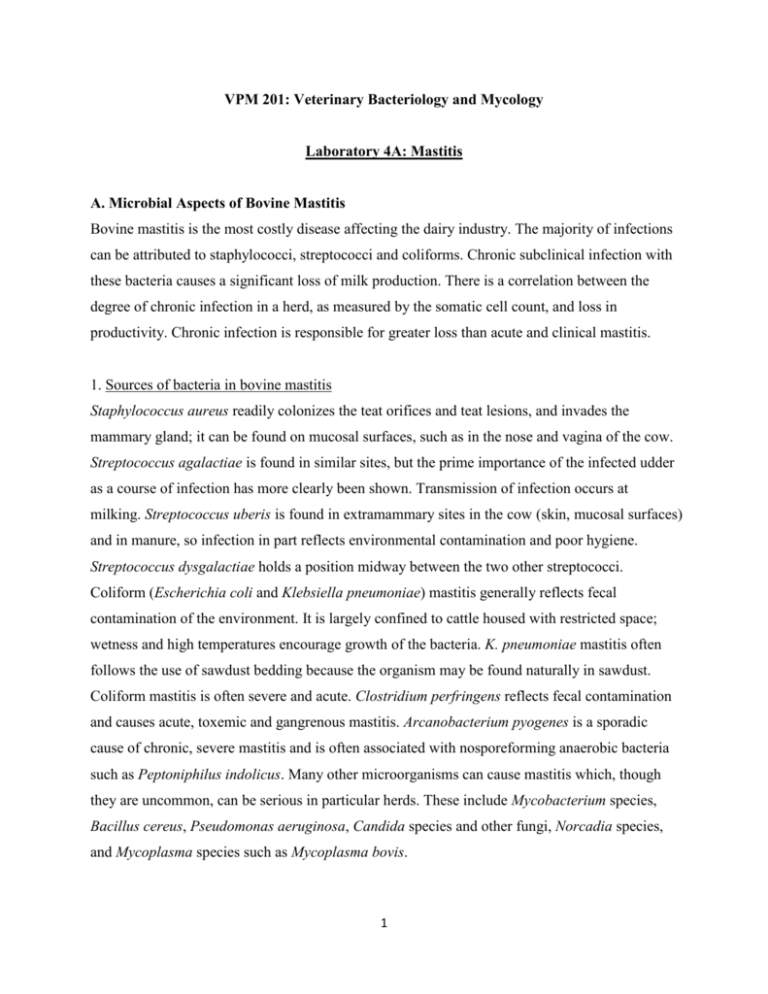
VPM 201: Veterinary Bacteriology and Mycology Laboratory 4A: Mastitis A. Microbial Aspects of Bovine Mastitis Bovine mastitis is the most costly disease affecting the dairy industry. The majority of infections can be attributed to staphylococci, streptococci and coliforms. Chronic subclinical infection with these bacteria causes a significant loss of milk production. There is a correlation between the degree of chronic infection in a herd, as measured by the somatic cell count, and loss in productivity. Chronic infection is responsible for greater loss than acute and clinical mastitis. 1. Sources of bacteria in bovine mastitis Staphylococcus aureus readily colonizes the teat orifices and teat lesions, and invades the mammary gland; it can be found on mucosal surfaces, such as in the nose and vagina of the cow. Streptococcus agalactiae is found in similar sites, but the prime importance of the infected udder as a course of infection has more clearly been shown. Transmission of infection occurs at milking. Streptococcus uberis is found in extramammary sites in the cow (skin, mucosal surfaces) and in manure, so infection in part reflects environmental contamination and poor hygiene. Streptococcus dysgalactiae holds a position midway between the two other streptococci. Coliform (Escherichia coli and Klebsiella pneumoniae) mastitis generally reflects fecal contamination of the environment. It is largely confined to cattle housed with restricted space; wetness and high temperatures encourage growth of the bacteria. K. pneumoniae mastitis often follows the use of sawdust bedding because the organism may be found naturally in sawdust. Coliform mastitis is often severe and acute. Clostridium perfringens reflects fecal contamination and causes acute, toxemic and gangrenous mastitis. Arcanobacterium pyogenes is a sporadic cause of chronic, severe mastitis and is often associated with nosporeforming anaerobic bacteria such as Peptoniphilus indolicus. Many other microorganisms can cause mastitis which, though they are uncommon, can be serious in particular herds. These include Mycobacterium species, Bacillus cereus, Pseudomonas aeruginosa, Candida species and other fungi, Norcadia species, and Mycoplasma species such as Mycoplasma bovis. 1 2. Routes of infection Infection reaches the udder through the teat canal. Minor microscopic abrasions predispose to infection, probably by exposing fibronectin to which S. aureus and other bacteria adhere. Occasional infections are nosocomial because of contamination of dry cow antibiotic preparations. 3. Natural defenses of the bovine udder A major defense against infection is the anatomic barrier of the teat sphincter and the washout effect of milking. The major immunoglobulin in milk is IgG but this is present in relatively small quantities because of dilution. The predominant somatic cells in milk are the macrophages. They have relatively poor bactericidal activity, but are important in antigen processing. Neutrophils in milk are the major effector cell but are also poorly bactericidal, because of the inhibitory effects of casein and fat globules which they phagocytize. The relatively poor immune defenses of the lactating udder contrast with the efficient antibacterial nature of the non-lactating udder which is protected by large quantities of lactoferrin and citric acid, both of which prevent bacteria from acquiring the iron they require for growth. The udder of the cow in the postparturient period is most susceptible to infection. B. Assessment of Cellular Response to Intramammary Infections The number of somatic cells in milk can be quantified directly by microscopic counting or by the use of an electronic particle counter, or indirectly by tests in which nuclear DNA is polymerized to a gel by a detergent. One indirect method is the California Mastitis Test (CMT). In this method, 2mL of milk is transferred to the cups of a special paddle and 2 mL of CMT reagent added. The mixture is gently swirled for 10 seconds and examined for a precipitate and thickening or gelling of the mixture. The reaction is scored as follows. The reaction may fade if shaking too hard or kept for more than 15-20 seconds. 2 Scoring System 0 – Mixture liquid, no evidence of precipitate. Trace – Slight precipitate, especially on tipping backwards and forwards; may disappear. 1 – Distinct precipitate, no tendency to gel. 2 – Mixture thickens immediately, some suggestion of gel. 3 – Heavy gel formation. C. Bacterial isolation and identification 1. Sampling – Samples should be taken just before milking and after discarding foremilk. Udders and teats should be washed with clean warm water and dried with paper towels. Carefully scrub the teat end and orifice with cotton pledget moistened with 70% alcohol. Collect milk into sterile container without touching sample. Samples should be cultured immediately or stored at 4 ºC until cultured, which should be within 24 hours. 2. Culturing – Warm milk to 25 ºC, shake well by inversion, and let foam disperse. For quarter samples or composites, aliquot 0.01 mL (10.0 μL) to one quadrant (quarter) of a plate. Incubate 35 ºC for 24 and 48 hours. 3. Gram stain – A gram stain should always be done on milk from cows with severe mastitis, but is not usually done in mild mastitis. 4. Preincubation of milk samples – This is routine practice in some laboratories but has no place except for isolation of S. agalactiae. Milk is an excellent culture medium and one bacterial contaminant can readily multiply. 5. Interpretation – In acute mastitis, bacteria are found in large numbers. In chronic mastitis, bacteria may be present in low numbers but most workers require more than 5 colonies as presumptive evidence of an intramammary source and not of contamination. 3 D. Laboratory Exercises 1. Three swabs (A, B and C) are milk samples from mastitic cows. Please inoculate on BA, MAC and Edwards agar (see Appendix B of your laboratory handbook) using a standard quadrant streak pattern. They will be incubated overnight. Label plates carefully, otherwise your lab tomorrow will be messed up. 2. You are provided with BA and MAC plates inoculated with two bacterial isolates (2A and 2B) from dairy cows that developed acute mastitis. Record your information in the table below. a. Examine the culture plates provided (growth, morphology, hemolysis, lactose fermentation…) b. Perform gram staining c. Results of citrate and urease tests (see lab handbook Appendix B) are provided as demo 2. d. Based on the observations, make a tentative identification of 2A and 2B. Growth E. coli Klebsiella pneumoniae Gram (+/-) BA MAC (Yes/No) (Yes/No) + + - + + - 1 Lactose Fermentation 2 Citrate 3 Urease (+/-) (+/-) + - - + + + (+/-) : Pink colonies on MAC indicate “lactose-fermenter” : Blue means “positive” 3 : Pink means “positive” 1 2 K. pneumonia produces highly mucoid colonies!!! 3. Gram stained smears (Slide sets 7-2, 7-3, 7-4, and 7-5) of milk from 4 cows with chronic mastitis are provided. They are Nocardia (7-2), Streptococcus agalactiae (7-3), Candida albicans (7-4), and Arcanobacterium pyogenes (7-5). Describe your microscopic observations (morphology…). 4 E. Demonstrations 1. California Mastitis Test (CMT; Appendix C) will be demonstrated at the front of the class. Is this a direct or indirect measure of somatic cells in milk? CMT measures somatic cells indirectly 2. Results of citrate and urease tests of 2A and 2B. 3. Merial J-VACTM vaccine for E. coli mastitis. 5 Laboratory 4B: Mastitis, Bacillus and Mycobacterium A. Bacillus The genera Bacillus spp. are gram-positive and produce spores. Bacillus anthracis (not provided) forms capsules, and is non-hemolytic. Other Bacillus species, such as B. cereus, are hemolytic and mostly are found as contaminants in clinical specimens. B. Mycobacterium Do not take up gram-stain (some may be “beady” Gram-positive). Acid fast (Ziehl-Neelsen) staining is required. Mycobacteria stain pink/red and the background is typically blue. For isolation, specimens are decontaminated, and inoculated into tubed media (e.g., LowensteinJensen) and incubated for up to 8 weeks for M. tuberculosis, M. bovis and M. avium. C. Exercises 1. Examine the BA, MAC and Edwards plates you inoculated yesterday. Conducts catalase test and gram-staining, and complete the Table below. CAMP tests are provided as “Demo 1”. Please make your presumptive identification of it; the table on the next page will be helpful to you. Sample A Sample B Sample C Growth on BA plate (Yes/No) Yes Yes Yes Growth on MAC plate (Yes/No) No No No Growth on Edwards plate (Yes/No) No Yes Yes + + + cocci cocci cocci Gram staining (+/-) Microscopic morphology (rod, coccus?) Hemolysis (complete, double zone…?) Catalase (+/-) double zone complete but weak nonhemolytic + - - CAMP test (+/-) N/A + - 1 N/A - + Staph. aureus Strep. agalactiae Strep. uberis Esculin hydrolysis (+/-) Your presumptive I.D. 1: Edwards can differentiate between esculin-positive and negative organisms. 6 Lancefield Hemolysis CAMP group Edwards Esculin Hippurate agar Staph. aureus NA double zone NA no growth NA NA Strep. B β (weak) + + - + arrow-head agalactiae Strep. C α - + - - Variable α, γ - + + + dysgalactiae Strep. uberis D. Demonstrations 1. CAMP test of Samples B and C. 2. Examine the BA culture of Bacillus cereus and the gram-stained morphology of B. cereus (Slide set #10-1). Please don’t open the culture plate! 3. Examine the photograph of B. anthracis. 4. Examine the acid-fast stained Mycobacterium in histological preparation of ileum mucosa from a cow suspected of Johne’s disease. 7

